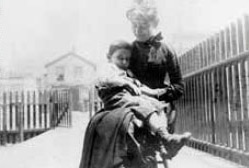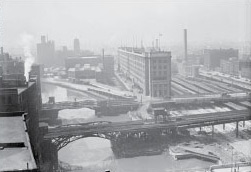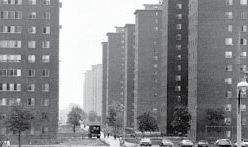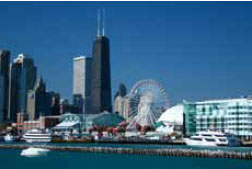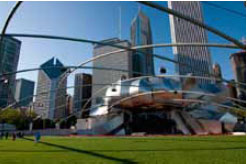1779
- Jean Baptiste Pointe du Sable builds the first permanent, non-indigenous settlement in what is now Chicago.
1833
- The Town of Chicago is incorporated with a population of less than 200.
1836
- An early map drawn by canal commissioners describes the land which is now Grant Park as “Public Ground—Common to Remain Forever Open, Clear and Free of Any Buildings, or Other Obstruction Whatever.”
1848
- The Illinois & Michigan Canal, linking the Great Lakes and the Mississippi River waterways, is completed.
- The first railroad tracks are laid in Chicago, soon making it the railroad hub of the nation.
1850
- Chicago’s population, skyrocketing more than 500 percent in one decade, reaches 29,963.
1869
- The Illinois State Legislature creates three separate Park Commissions to maintain and extend public park land, and to develop an interconnected boulevard system.
1871
- The Great Chicago Fire rages for 36 hours and reduces a third of the city to rubble and ash. Aided by an outpouring of international charity, the city rebuilds and cleans up most signs of destruction within one year.
1889
- Construction begins on the Sanitary and Ship Canal, which will reverse the flow of the Chicago River when completed.
- As the city’s population continues to grow rapidly, Jane Addams and Ellen Gates Starr establish the Hull House settlement house on the Near West Side to address squalid and crowded living conditions, illiteracy, poverty and disease.
1890
- Fighting for public access to the lakefront, mail-order retail magnate Aaron Montgomery Ward successfully sues the City of Chicago for removal of structures and cleanup of the land that will become Lake Park (later Grant Park).
1893
- The World’s Columbian Exposition attracts 24 million attendees and raises the profile of architect Daniel Burnham, chief designer and supervisor of construction.
1897
- The Union Elevated Railroad constructs the elevated Loop connecting several passenger rail lines that serve the city.
1900
- Chicago, population 1,698,575, is the fifth largest city in the world.
- The flow of the Chicago River is reversed using a series of canal locks, causing the river to flow west instead of east, into the newly completed Chicago Sanitary and Ship Canal.
1901
- The Tenement Conditions in Chicago, a scathing report on the living conditions of the Near West and Near Northwest sides, is published.
1908
- The “Brennan system”, named for building superintendent Edward P. Brennan, standardizes street naming and numbering across Chicago’s vast grid. State and Madison streets become the city’s primary axes, and street address numbers now register distance and direction.
1909
- The Plan of Chicago is approved in March and revealed ceremoniously on July 4.
1912
- Daniel Burnham dies at the age of 65 during a visit to Germany. Between now and 1931, Chicagoans approve some 86 Plan of Chicago-related bond issues covering 17 different projects with a combined cost of $234 million.
1916
- The Great Migration of African Americans from the rural South to the industrial North begins in earnest.
- Municipal Pier (now Navy Pier) is completed.
1925
- Union Station is completed and haphazard railroad tracks are realigned.
1926
- The upper/lower riverfront drive, which routes commercial traffic around the Loop and beautifies the riverfront, is opened and named for Chicago Plan Commission Chairman Charles Wacker.
1937
- Chicago Housing Authority (CHA) is established.
1939
- The Chicago Plan Commission is reorganized and absorbed into city government.
1943
- Master Plan of Residential Land Use of Chicago is published by the Chicago Plan Commission, outlining issues in housing.
1945
- Chicago Transit Authority is established.
1950
- African American activist Robert Taylor resigns from the CHA board when the city council refuses to endorse potential CHA locations that will stimulate racially integrated housing.
1955
- Mayor Richard J. Daley is elected for the first of five terms.
1959
- Chicago’s new Department of City Planning prepares the Development Plan for the Central Area of Chicago. Among its recommendations are a civic center east of the City Hall-County Building (now the Richard J. Daley Center), the State of Illinois Center (now the James R. Thompson Center), the relocation of the University of Illinois at Chicago from Navy Pier to its current campus west of downtown, and residential development just south of the Loop and on the Near North Side.
1962
- The Robert Taylor Homes are completed, becoming the largest public housing project in the United States. The 28 buildings contain almost 4,300 dwelling units and 27,000 people. Although meant to be an improvement over the slums they replaced, the buildings turned into hot zones for a host of social problems, as did many high-rise projects across America.
1963
- O’Hare Airport opens.
1966
- The Comprehensive Plan of Chicago is published the Chicago Plan Commission, emphasizing improvements to the living conditions for families, working people, and the disadvantaged.
1970
- Union Stock Yards close.
1972
- “Rush-hour” bicycle lanes open on Clark and Dearborn Streets.
1973
- Another city plan is published, Chicago 21, addresses the deterioration of the central city. It includes improvements in transportation and the location of some city colleges and private university facilities in or near the Loop.
1983
- Harold Washington is elected as the city’s first African American mayor.
1986
- Mayoral allies win a lawsuit against the city in Federal Court, claiming that the ward map created after the 1980 census had unfairly dispersed African American and Hispanic voters. The Federal Court orders modifications to the borders of seven wards, as well as special elections in those wards.
1989
- Richard M. Daley is elected mayor. In 2011 he becomes the longest serving Chicago mayor after 22 years in office.
1995
- Navy Pier reopens as a recreational facility with restaurants, entertainment, shops and other attractions.
1998
- Construction begins on Millennium Park. Substantial private funding allows such world-class artists and architects as Jaume Plensa, Frank Gehry, Thomas Beeby and Anish Kapoor to contribute major works to the park.
2000
- The U.S. Department of Housing and Urban Development approves the Chicago Housing Authority Plan for Transformation, developed with input from elected resident leaders and the City of Chicago. Under the plan, the CHA will improve the appearance, quality and culture of public housing in Chicago.
2001
- A plan is created by Chicago Metropolis 2020, subtitled The Chicago Plan for the Twenty-First Century.
2004
- Millennium Park opens.
2007
- The last remaining building from the Robert Taylor Homes is demolished. A total of 2,300 low-rise residential homes and apartments, seven new and renovated community facilities, and a number of retail and commercial spaces are to be built in place of the old high-rise buildings.
Sources
- Smith, Carl. The Plan of Chicago: Daniel Burnham and the Remaking of the American City. University of Chicago Press, 2006.
- Condit, Carl. Chicago, 1910-29: Building, Planning and Urban Technology. University of Chicago Press, 1973.
- Condit, Carl. Chicago, 1930-70: Building, Planning and Urban Technology. University of Chicago Press, 1974.
- The Encyclopedia of Chicago. Chicago Historical Society and The Newberry Library, 2009.
Content last updated: October 31, 2009

